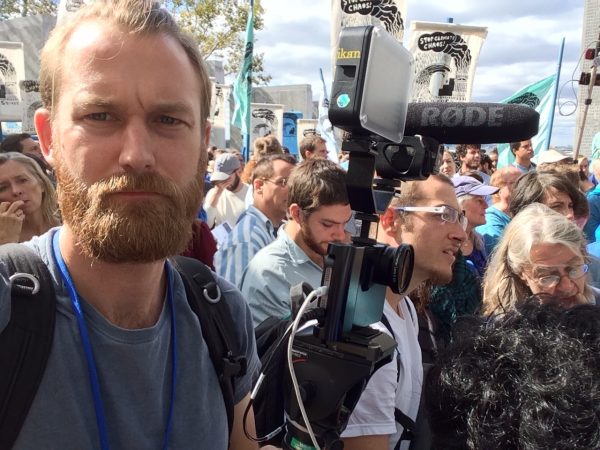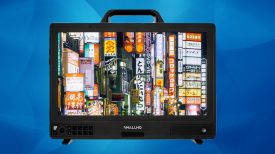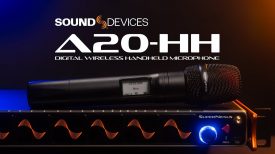Guest post by Japhet Weeks of AJ+:

AJ+, the new digital oriented news outlet from Al Jazeera media network, were at the People’s Climate march in Manhattan recently shooting entirely with mobile devices. We also covered the Flood Wall Street protest and UN Climate Summit the same week and I believe we were the only news organization to use all mobile coverage from the events.
Here is the gear I used:
3x Apple iPhone 5/5s. Each phone had a different carrier: Verizon, AT&T, and T-Mobile
Manfrotto monopod
Small Rode shotgun mic for input into camera to capture ambient sound.
Audio Technica wired lav mic for interviews.
On board iKan LED light for indoor interviews and night time shooting.
Housing for iPhone with wide-angle lens adaptor – allowing the iPhone to attached to a monopod
Bracket for mounting a Rode Videomic Pro shotgun mic and LED light.
Two external battery packs for the iPhones. Battery life is a problem for whole day shooting – you will need extra power.
And here are some of the results:
Audio Issues:
With this setup the biggest issue was audio. Initially I planned to use two apps to record the video – Filmic Pro and ProCam. Both allow monitoring of the audio input, but it transpired that both were too buggy to be dependable. ProCam seemed fine at first, but on playback the audio didn’t sync up with the video. Filmic Pro tended to crash. In the end I went for the native camera app, which didn’t allow audio monitoring but was more stable.
Since I wasn’t able to monitor audio, I would fire up ProCam first to test that the iPhone was recording audio through the shotgun mic or lav, then I would go back into the native camera app to record. As this method wasn’t foolproof I would quickly play back the interviews to make sure the audio quality was OK. I’m going to keep looking for better apps that allow you more control of image and especially sound.
The Audio Technica lav mic I was using performed extremely poorly in the wind even with the windshield attached.
Pictures and editing:
The size and weight of the iPhone rig and the monopod allowed me to move fast and get close to the action. This meant I got images that other journalists were simply unable to get. When the polar bear character was arrested at Flood Wall Street I was able to extend the monopod and shoot over the heads of NYPD officers. The weight and size of the phone made this possible.
Before transmitting footage, I edited it, either in the native camera app or in iMovie. This allowed for faster transmission as the bytes were smaller.
Transmitting footage:
Prior to being in NYC, I had experimented with different methods of transmitting what I shot. I tried DropBox, YouTube, Vimeo and email before finally discovering that the best method was sending via Slack’s mobile app, which allowed us to transfer uncompressed footage back to the team in SF.
To ensure the best data coverage I used three iPhones each with a different carrier. These were Verizon, T-Mobile and AT&T. I consider this essential for mobile video journalists (MoJos) because different networks work differently in different situations. So many users in one place can cause networks to overload and data rates can drop massively. For this story I found Verizon performed consistently well in New York, even in large crowds.
I was shooting and transmitting video at 1080P. Initially I thought that sending over LTE would require us to compress video to 720P, but in practice the network allowed relatively fast transfer speeds and we were able to send Full HD files. This was surprising considering the numbers at the event.
The beauty of this setup is that it allowed me to shoot and send almost in real-time. This is something that set AJ+ apart from many of the other news organisations at the Climate March and Flood Wall Street.
Conclusions:
The ability to transmit video quickly from the field also allowed us to publish moment-of, not just day-of, exclusive footage. There were activists live streaming and journalists snapping pictures on their iPhones, but AJ+ was the only news organization I saw shooting exclusively on mobile.
.
Shooting on an iPhone doesn’t give you creamy, cinematic shallow depth-of-field look of DSLR, nor super zoom range of a traditional news camera, but what it does give a journalist is the ability to shoot breaking news, file quickly, and then keep shooting. The lightweight set up gives you access to things you wouldn’t be able to get with larger cameras. The rig can always be broken down and made smaller, making the camera even more unassuming.
Things aren’t prefect yet though. The iPhone needs better, more stable professional apps for shooting video that have proper audio monitoring. Hopefully this will be resolved soon enough.
The possibilities for shooting news exclusively on mobile are really exciting and the technology needs to be pushed further.
Japhet Weeks is a senior producer with AJ+ in San Francisco. Before that he covered political turmoil as a VJ in the Middle East and Russia.





